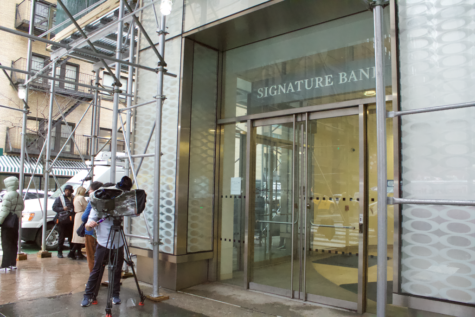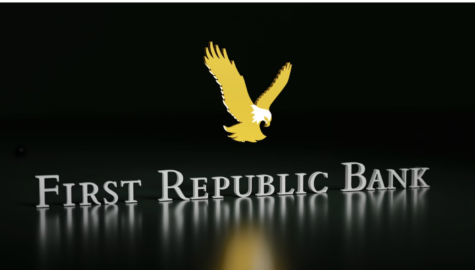Financial Fallouts and Bankruptcy Blues: An Analysis of the Banking Crisis
The sudden collapses of Silicon Valley Bank, Signature Bank, and First Republic Bank — the biggest bank failures since the Great Recession — have reinvigorated investors’ distrust and shaken the confidence of the American public.
總統府, CC BY 2.0
As various influential banks began to collapse, the economy was sent into an upheaval as stocks drastically dropped below value.
American industrialist and entrepreneur Henry Ford once said: “It is well enough that people of the nation do not understand our banking and monetary system, for if they did, I believe there would be a revolution before tomorrow morning.” Yet as monetary crises increase and technology begins to insert itself into financial affairs, people have become more invested in developing greater financial literacy. With the advent of technology, banking has become accessible to an entirely new demographic of individuals, leading to an increased demand for financial transparency from banks and the government. Fueling the flames of this criticism is the recent collapse of several notable banks including Silicon Valley Bank, Signature Bank, and First Republic Bank.
On March 10th, 2023, shockwaves were felt throughout the financial sector as bank officials announced the beginning of the end for Silicon Valley Bank (SVB). Despite being established just six years ago, the bank had quickly grown to become one of the largest lenders in the tech industry, serving a range of clients from start-ups to established giants like Google and Amazon. Its collapse marked the biggest bank failure since the 2008 financial crisis.
Two days earlier on March 8th, 2023, SVB stated that the institution needed to shore up its finances, announcing a deficit of $1.8 billion and its plan to raise $2.25 billion in capital to adapt to increased withdrawal requests. Despite the chief executive, Gregory Becker, urging venture capital firms to remain steadfast in their support of the bank, panic spread like wildfire on social media as some investors advised corporations to remove their money from the bank. Its stock plummeted overnight and clients withdrew about $40 billion.
The panic quickly spread to SVB’s peer banks, most notably Signature Bank. Their closing underscores the challenges that face small and midsize banks, which often focus on niche clients and have a narrower base of customers than larger banks such as JPMorgan Chase or Bank of America. This lack of diversification leaves them especially vulnerable to bank runs. The demise of Signature Bank has impacted several of the professional services firms that came to rely on the institution and its focus on providing banking services to law firms, escrow accounts for holding client money, and other services. Without the services of Signature Bank, these businesses are scrambling to adapt to their new circumstances, circulating widespread uncertainty and doubt.
Echoing the failures of Silicon Valley Bank and Signature Bank, First Republic Bank also collapsed after depositors and investors abandoned the institution, pulling their money and selling their shares in droves. Its woes also included massive real estate loans that lost value rapidly as interest rates rose, as well as a concentrated customer base of wealthy depositors who withdrew large amounts of money. However, many economists point out that First Republic’s financial problems were visible far before SVB’s collapse, with their stock being in free fall and their failure to navigate the Federal Reserve’s 2022-23 interest rate hike campaign. On May 1st, 2023, First Republic Bank officially ceased operations and The Federal Reserve sold most of its deposits and assets to JPMorgan Chase.
Several economists have varying conclusions regarding the bank failures: some experts view the bank runs as isolated events while others consider them to be reflective of the financial sector’s general state and act as a precursor for more economic turmoil.

Many maintain that the bank collapses were a singular event caused by fear-mongering instead of economic trends. As people took to Twitter to discuss how they were withdrawing their deposits, others followed until SVB did not have sufficient assets to satisfy deposit demand. Consumer-driven bank runs like the ones that occurred are rare as the majority of clients have deposits of less than $250,000, which the FDIC insures. However, because the majority of SVB’s clientele were companies whose amounts greatly exceeded that value, depositors began to collectively fear their money would be lost, leading to the consequent panic.
Furthermore, the banks had questionable business practices. SVB, for instance, had been heavily exposed to the struggling tech industry and had made several loans to start-ups that were unable to repay them. Signature Bank, meanwhile, had invested heavily in high-risk assets, including subprime mortgages and collateralized debt obligations (CDOs).
Others believe that the bank failures signify structural issues in the financial system and are the product of an unhealthy economy. By investing in bonds that would lose value if the interest rate rose, SVB relied on near-zero interest rates to maintain financial stability. This issue can be generalized to banks that invest in securities whose values depend on interest rates, knowing that they can change at any time.
In the end, it was these rising interest rates that played a pivotal role in the unfolding of the crisis. Dr. Andreas Hauskrecht, a clinical professor of business economics and public policy at the Indiana University Kelley School of Business stated, “When interest rates went up, two things happened: First, the startups and crypto investors felt a lack of access to financial sources and started to withdraw bank deposits. Second, the fixed interest assets of all three banks lost value. All three business models were only able in a very low interest rate environment.”
Following the bank collapses, the Federal Deposit Insurance Corporation (FDIC) announced that they would guarantee that all depositors in SVB and Signature Bank were repaid in full. The FDIC also offered banks loans against their Treasuries and many other asset holdings, treating the securities as though they were worth their original value — even though higher interest rates have eroded the market price of such bonds.
These actions have raised questions about the role of federal regulation in the banking industry. Some critics have argued that the collapse was a result of lax regulation, calling for tighter controls on the activities of banks and other financial institutions. Others have blamed the risks associated with the rapid growth of the tech industry, suggesting that greater regulation needs to ensure that lenders are not overexposed to this sector. While the intention behind federal intervention is often to protect the stability of the financial system and prevent widespread economic damage, some have concerns regarding the consequences and morality of these interventions.

One criticism is that government intervention can create a moral hazard. When banks know that they are likely to be bailed out by the government in the event of a collapse, they may engage in risky behavior, assuming that the government will bear the costs of their failures. This can incentivize banks to take excessive risks, prioritizing short-term profits without adequately considering the long-term consequences. This dynamic can ultimately exacerbate the instability of the financial system and increase the likelihood of future crises.
Dr. Hauskrecht continued, “The Federal Reserve and the Treasury effectively bailed out the depositors of banks with an unsustainable business model. This produces moral hazard. In other words, in the future everyone has no reason to be more careful because they get bailed out anyways by the Fed and the Treasury. This clearly sends the wrong market signal.”
Another criticism is the potential for government intervention to distort market forces. When the government steps in to rescue failing banks, it disrupts the natural process of market discipline and resource allocation. In a free-market system, inefficient and poorly managed banks should be allowed to fail, as this encourages better risk management practices and promotes competition. By propping up failing banks, the government shields them from the consequences of their actions, distorting the market and potentially creating an environment where poorly managed institutions continue to operate at the expense of more responsible ones.
Dr. Rodney Ramcharan, professor of finance and business economics at the University of Southern California Marshall School of Business reflected, “Banking is a public utility that by nature is inherently fragile. Bailouts are unfair to regular people who, when they mismanage affairs, don’t get bailed out. They are unfair to the smaller banks because they are not significant enough to warrant a bailout because they are so small. But unfortunately that is the system that we’ve created, where if we didn’t bail big banks out, they would lead to even more damage.”
Yet, others view the FDIC’s actions as positive in hindsight. Mr. John Powell, a Bronx Science AP Physics 1 teacher, gives an alternative perspective on the issue. He believes that, “Ultimately, the FDIC did a good thing to combat inflation.”
However, it is important to acknowledge that bank collapses cannot be completely eradicated. The financial landscape is inherently dynamic and subject to various uncertainties. There will always be new risks and challenges emerging, requiring continuous adaptation and improvement of regulatory frameworks. Although some bank collapses can be predicted to an extent, the vast majority of them cannot be. Dr. Ramcharan compared the unpredictable nature of banks to the everchanging weather. “It’s like forecasting the weather. At some point, you’re going to get hit by a hurricane exactly when that occurs. It’s hard to say,” he said.
Ultimately, bank collapses pose significant threats to financial stability and the overall economy. While progress has been made in enhancing regulations and using technology to increase financial literacy, constant vigilance and adaptation are necessary to mitigate the risks associated with bank failures. By learning from past failures and implementing proactive measures, we can strive to build a more robust and resilient banking sector that withstands the challenges of the future.
The financial landscape is inherently dynamic and subject to various uncertainties. There will always be new risks and challenges emerging, requiring continuous adaptation and improvement of regulatory frameworks.
Pritika Patel is an Editor-in-Chief for ‘The Science Survey.’ She believes that journalism serves as the vital connection between people and the world...

